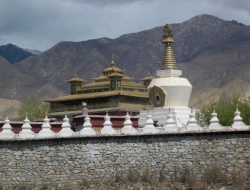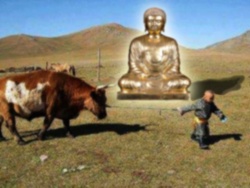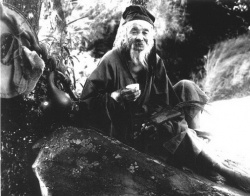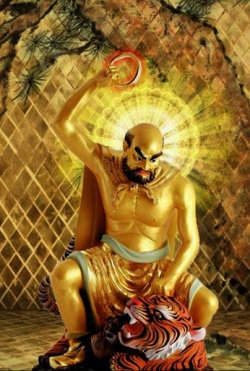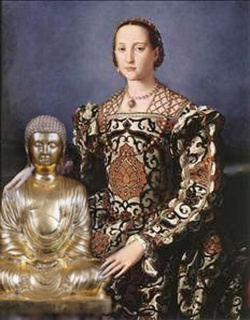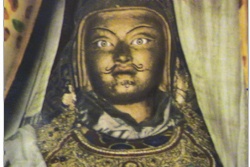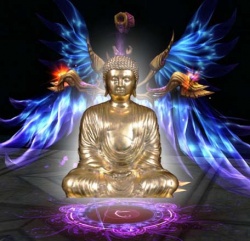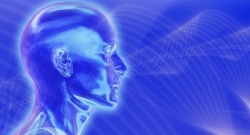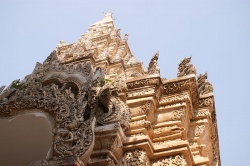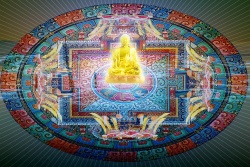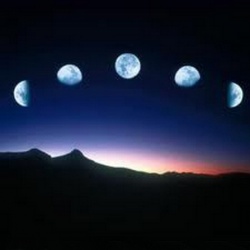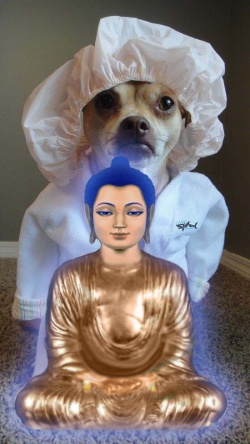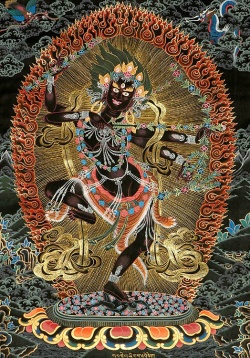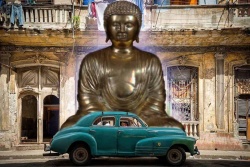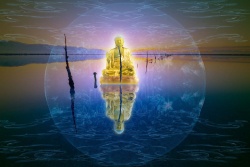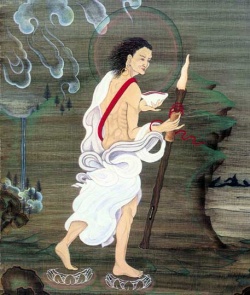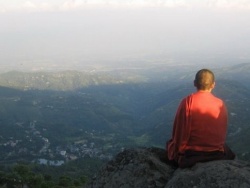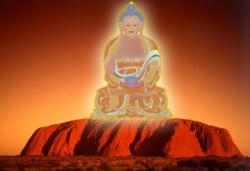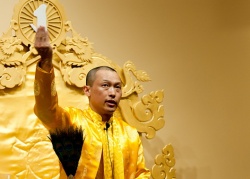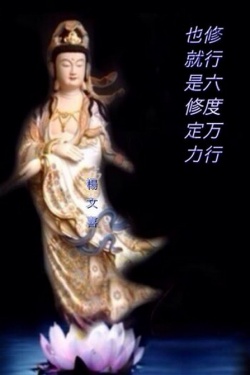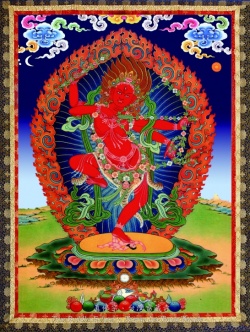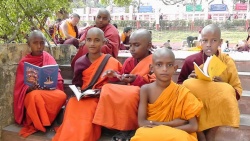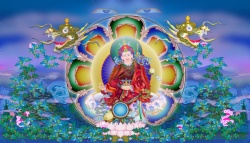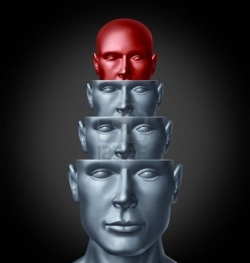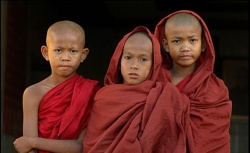Studies in Buddhist Dogma
By Louis De La Vallee Poussin, M,R,A,S. The Journal of the Royal Asiatic Society of Great Britain And Ireland for 1906
THE THREE BODIES OF A BUDDHA (TRIKAYA).
ONE of the more interesting features of the Great Vehicle, or Mahayana School of Buddhism, is the system of tile Three Bodies. Being at first a 'Buddhology, ' a speculative doctrine of the Buddhahood, this system was afterwards made to cover the whole field of dogmatic, of ontology, and was in particular substituted for the antiquated 'dependent origination' (pratityasamutpada).
At first the Buddhas alone had three 'Bodies'; afterwards the whole universe was looked upon as residing in or made of the Bodies.
Later, or by parallel development, new mythological, mystic, and physiological reveries caused serious alterations of the primitive 'trinitarian' form, and in particular the addition of two more Bodies to the 'classical' ones;
and the Tantric school, in its own fanciful, mystic, and theurgic way, reduced the speculative system to a mere practical method of Yoga.
Much has been written by several scholars on the Trikaya.
The latter form of the trinitarian theoty, its philosophical aspects, and its points of contact with Hindoo cosmologies have been thoroughly elucidated by the able observations of Professor Kerm; whereas Wassilieff has thrown some light on its older signification, we mean the theological and truly
---------------------------- 1 See Journal Asiatique, 1902, ii, 237; 1903, ii, 358; Museon, 1905, 178.--The MS. of the prestent article has been kindly revised by Dr. W. H. D. Rouse.
Buddhistic one. There are also documents on the Tantric aspect of the three or five Bodies scattered in the works on later or Tibetan Buddhism.(1)It seems, nevertheless, that something remains to be said.
There is no hope of fully illustrating the antecedents, the growth, and the numerous alterations of the dogma under examination, as it is too intimately connected with Buddhist dogmatic as a whole and the history of the schools.
But even if our researches should be completely wanting in chronological accuracy, and even fruitless as concerns the historical development of the Faith, we are confident that they will to some extent ascertain the meaning of some important Buddhist tenets.
At least it is interesting to gather new original documents and to collect the interpretations which have been presented by native or European authorities.
It is a common misfortune when dealing with Indian or Buddhist topics that comprehensive and detailed accounts are far from being clear, and that intelligible summaries are always somewhat misleading.
The genuine methods of the Indian thought are on the one hand the genial but incoherent effusions of the Brahmana-Upanisads, on the other the pedantic categories of the Brahmanic or Buddhist 'matrkas' (compilations of technical terms).
The Buddhists of old, as a rule, scarcely realize what they mean, and the best scholastical statements and nomenclatures of the Sutras.
Therefore, tradition must be squeezed through a filter if one wants coherent theories. This very case offers special difficulties, because the philosophical views are mixed together with
----------------------------- 1 See H. Kern, "Over den aanhef eener Buddhistische Inscriptie uit Battambang (Versl. en Med. der k. Akad., Letterkunde, 4e r., 3 deel, Amsterdam, 1899), French translation by L. de la Vallee Poussin, Museon, 1906, 46; Wassilieff, Buddhism, p. 127; Schlagintweit, Waddell, passim.--Csoma, Jaschke, Eitel, see below, pp.946, 958, 968.--A small treatise, Kayatraya Kandjur, Mdo, xxii, 16 (Csoma-Feer, p. 274), has been translated by Rockhill, " Life of the Buddha," pp. 200-202.
theological postulates find mythological traditions, because we gather documents from Sutras so old as the Prajnaparamitas, the Saddharmapundarika , or the Amitayurdhyanasutra, down to the Tantric literature , which knows too much about Jinas (the so-called Dhyanibuddhas) and Vajrasattvas.
We shall endeavour to make out the prominent lines of the diverging theories, and to characterize their mutual relations. The expose of the sources will enable the reader to correct or to complete our very imperfect sketch.
General view of the matter
I. The doctrine of the Trikaya as Buddhology, after its completion, but yet free from 'ontological' and cosmogonic speculations.
(A) The very nature of a Buddha is the Bodhi (Enlightenment), or Prajnaparamita (Perfect Wisdom), or knowledge of the Law (Dharma), i.e. of the absolute Truth.
By acquiring this knowledge, nirvana is realized in potentia or in actu.
The Dharmakaya, Body of Law, of a Buddha is the Buddha in nirvana or in nirvana-like rapture (samadhikaya = dharmakaya).
(B) A Buddha, as long as he is not yet merged into nirvana, possesses and enjoys, for his own sake and for others' welfare, the fruit of his charitable behaviour as a Bodhisattva.
The second body is the Body of Enjogment or Beatific Body (sambhogakaya)
(C) Human beings known as Buddhas are magical contrivances (nirmanakaya) created at random by real Buddhas, i.e. by Buddhas possessed of beatific bodies sovereigns of celestial worlds, Tusita-heavens or 'Paradises' (Sukhavatis).
II. The doctrine of Trikaya as an ontologic and cosmologic system.
p.946 947 (A) By Body of Law one has to understand the void and permanent reality that underlies every phe nomenon (dharma), or the store of the 'dharmas,' or more exactly the uncharacterized Intellect (vijnana).
(B) Body of Enjoyment is the Dharmakaya evolved as Being, Bliss, Charity,
Radiance, or the Intellect as far as it is individualized as Buddha or Bodhisattva. (C) Magical or rather Transformation's Body is the same Intellect when defiled, when individualized as 'common people' (prthagjana), infernal being, etc.
I. DHARMAKAYA, BODY OF THE LAW
--------------------------- 1 See Csoma, Diet., p. 305, "The Supreme Moral Being"; Jaschke, Diet., p.22a, "Absolute Body, Buddha in the Nirvana, the so-called first world of abstract existence, i.e. non-existence "; Eitel, Handbook, p. 179; sources quote by St. Julien, " Voyages," n ii, 224; Wassilieff, pp. 127, 286. 2 Sarvaprapaneavyatirikto bhagavatam svabhaviko dha rmakayah sa eva cadhigamasvabhavo dharmah. (Bodhicaryavatarapanjika, 3. 16.)
According to Csoma, Diet, p.305 the svabhavakaya should be a fourth and yet more sublime body: the body, substance, or essence of nature itself, the First Being, God."--Jaschke, Diet., p.22a, supports the same view:
"More recent speculators hare even added a no-bo-nid-sku superior to the three, viz., that which is eternal in the essence of a Buddha, even chos-sku, the absolute body, being deseribecd by these philosophers as transient."
[That would very well suit the conclusions at which Professor Kern arrives (op. cit., p.72 = Museon, 1906, 55): "For the Realists (and amongst Buddhists Realism
suddhakaya, (1) that is to say, the Body in its true nature, resting in itself, free from developments (prapanca) or external coverings or hindrances (avarana) , translucid or radiant(prabhasvara)
1. THE DOCTRINE OF THE DHARMAKAYA AS BUDDHOLOGY.
(1) The material bony of Buddha contrasted with Buddha as the Law embodied.
As early hints or foreshadowings of the 'Body of Law,' one can quote the identification of the Law with the Buddha, to be met frequently in the Pali literature: " To see the Law is to see the Buddha."
To follow Sakyamuni and to touch his robe is not to see the Buddha: "He is far from me and I am far from him, because he has not seen the Law."
(2) The meaning seems to be that, when one has understood the Dharma, i.e. the doctrine of dependent origination (pratityasamutpada),(3) one has seen the best of a Buddha, one has reached everything that can be derived from a Buddha.
Preachers first and foremost and preachers only,(4) the Buddhas are the 'embodied Law' or the 'living law'; in
------------------------ had supporters) is the Dharma something really existing; not so for the Idealists of the Mahayana: according to them Dharma is a production of the mind, of the Samvrti, and therefore an appearance, a kaya, a body: therefore the Mahayanist can consider the Body of the Law like the two others, as an apparent manifestation of the sole and real Being."]
I think that the 'svabhavika kaya as a fourth body is a Tantric conception (see below, p.977). We are said in the Amrtakanika, a commentary to the Namasamgiti (v.156), that the Law-body (styled 'yuganaddhakaya'), to be knomn by the ascetic in himself, is different from the 'sambhogikakaya' (Enjoyment-body) and from the 'svabhavika'(the very Body, etc.). 1 Kalacakra, quoted ad Namasamgiti, [Amrtakanika]], v. 92. 2 See Minaveff, Recherches, p.218 n. 2.--Mahaparinibbanas. 60; Itivuttaka, 91. 12; Sam. N. III, 120; Saddhammasangaha, 62.3 (J.P.T.S. 1890) Salistambasutra, quoted Madhyamakavrtti,p.6, note 2. 3 Majjh. N. I, 191. 1; Salistambasutra. 4 "You yourself must make an effort: the Tathagtas are [only] preachers."
the same way, after the nirvana, the Law must be the ruler of the Church, the Refuge, a living Buddha. Further, the phrase dharmakaya, with the same import , in the Divyavadana and in a Jataka,
(2) contrasted with rupakaya or bhutikaya, 'material visible body.' Srona Kotikarna wanted to see the material body of the Master; he had but seen the Buddha in his Law-body, that is to say, he knew the sacred books, of which he gives a very interesting list.
In fact, 'dharmakaya' can be and is understood as an equivalent of 'dharmasamuha,' the collections of the books, the second jewel (ratna).(
3) Chinese authorities confirm this distinction of the two bodies: "Primitive Buddhism (in Chins)," says Eitel,
"distinguished a material, visible, and perishable body (rupakaya) and an immaterial, invisible, and immortal body (dharmakaya) as attributes of (Buddha's) human existence."(4) It would perhaps be more exact to state that the 'material body' of a Buddha is his 'body,'
endowed with the marks which he already possesses as a Bodhisattva(5); whereas his 'soul' or his knowledge is his Body of Law, eternal and inalterable, a "series of undefiled principles,"(6) the same in all the Tathagatas, and beyond the range of thought:
"The Buddhas ought to be looked upon b as equivalent to the Dharma; the leaders indeed are the Dharma embodied; the nature of the Dharma is beyond the discriminative powers of mind."
(7) ------------------------- 1 See Div. 19. 11, 20. 23. 2 See the story of Upagupta, ibid. 356 (Windisch, Mara und Buddha, 161). Cf. the Pali text edited Bulletin de l'Ecole Francaise, 1904, 420 (where occurs bhutikaya). [Also, as synonyms: tathagatam vapus, bauddham rupam.
3 See Bodhicaryavat. p.3.18: samuhartho va kayasabdah.... [dharmakayasabdena] pravacanasya grahanam. 4 Handbook, p.178. 5 See below, p.962, n.2; p.971, n. 2. 6 dharmakaya=anasravadharmasamtana (Abhidharmakosav. MS. Burn. 443b). 7 See Vajracchedika, Max Muller's edition, p.43 (Aneed. Oxon. i, 1).
Read: dharmato buddha drastavya dharmakaya hi nayakah, dharmata capy avijneya na sa sakya vijanitum], Madhya makavrtti, xxii, ad finem; Bodhicaryav. ix, 38.
(2) Dharmakaya = Bodhi = Nirranr,.
It is the knowledge of the truth (tattvajnana), the 'arriving at' or understanding the truth (adhigama = dharma) (1) that makes a Buddha.
A Buddha's mind is made of the 'knowledge of the non-birth of anything'(anutpadajnana).
(2) Now the true knowledge being styled 'Dharma' or 'Prajnaparamita,' there is no wonder that the Buddha's real nature should be defined as 'dharma' or 'prajna,' whereas 'prajna' is styled the mother of the Tathagatas.
We read that "Prajna is the real body of the Tathagatas";(3) that "all the Buddhas, past, present, and future, have for body the Dharma."(4)
Prajnakaramati, the commentator of Santideva's Bodhicaryavatara, well illustrates this topic: "The Bodhi or Buddhahood is the absolute (paramartha) reality; empty of any essence, be it unique or multiple; neither born,
nor extinct; neither perishing, nor permanent; free from any cogitable contingency, ather-like; it has for name Dharmakaya.
From the point of view of practical truth, it is styled Prajnaparamita, Void, Suchness, Actual (or real) apex, Element of existence, etc."(5)
------------------------------ 1 see above, p.946, n.2, and Madhyamakavrtti, xxiv, 4, where a fourfod meaning is given of the word dharma: phaladharma (=nirodha), phalavataradharma (=margasatyam) , agamadharma (= desana) , and adhigamadharma. 2 See Madhyamakavatara, quoted below, p. 962. 3 Astasahasrika Praniaparamita, 94.
11. A single manuscript of the Prajna is worth the whole Jambudvipa full of relies, because the Prajna is the real body (bhutarthika sarira) of the 'Tathagata. Bhagavat has said: "Do not believe that this [material] body is [my] true body (satkaya)...." 4 Ibid., 462. 1.
n short, the 'Body of Law' of a Buddha is his possessing Nirvana in actu or in potentia, as Occidental scholastics would say.
The synonym, given by a Tantric Commentary, 'samadhikaya,' 'the state of highest trance,' is a very good one.(1) Just as an Aupanisadic ascetic merges into.
Brahman during dreamless sleep, in the same way the Buddhist adepts in 'unconscious abstraction' realize the Body of Law, but for a time only.
The Bodhisattva, on the contrary, since he has become a Buddha, does not abandon the state of trance,(2) i.e. his never to be
abandoned real Body.
2. DHARMAKAYA AS AN ONIOLOGICAL PRINCIPLE.
The dialectie of the old Suttantas, put in the best; scholastical frame by the Madhyamikas and already driven to its last results in the Prajnaparamita books, seems to be such as to prevent any positive system.
It aims at an absolute denial of the reality of anything, substance or appearance. Not only the old lesson on 'soullessness' (nairatmya) coupled with 'dependent origination,'
excludes the notion of being, and reduces the whole world to a process of becoming , but enquiries on causality, on 'momentaneity, ' on the theory of knowledge, turn to the negation of the very becoming of things.
The 'samsara is a mere show, like the water in a mirage, like the daughter of a barren woman. Nor is nirvana or Buddha anything:
"The Buddhas are namas only, and if there be any more distinguished (visista) a thing than a Buddha, I should say it is a mere name."
Everything merges into void; but the distinction of the two truths provides the doctors with
-------------------------- 1 Amrtakanika ad Namasamgiti, v. 146.--See J. de Groot, Code du Mahayana, p.16.--Perfect samadhi however, is said to be the characteristic of the sambhogakaya (Trikya, translated by Rockhill, p.200). 2 See the sources quoted in Bodhicaryavatara, ix, 36, and also J.R.A.S, 1902. p. 374, n. 1.
a rather solid basis for the establishing of a Path (relative truth) leading to nirvana (highest truth or void).(1)
Nay, actual voidness is a postulatum of this very Path! If there were something, this 'something' could not be extinguished. In fact, like the Buddhists of old, the Madhyamikas are almost exclusively interested in final release (moksa); and, in general, one may say that the Orthodox (amongst whom are the Madhyamikas) have elaborated metaphysics (skandha-theory, dependent origination, void, momentaneity) chiefly to support their eschatology and the practices leading to one's end, be it Arhatship or magnified Buddhahood.
There are many Sutras (scriptural texts) and Sastras (treatises) to inform us whither are going the Arhats and the Buddhas, i.e. the purified or magnified individual beings;
they are going to nirvana alias Buddhahood or dharmakaya. And the good middle Path is also fully described. But whence come the individual beings?
The Orthodox, the Madhyamikas in chief, content themselves with stating that there is a term to samsara, an apex or limit of being (bhutakoti), but that 'samsara' or becoming' has had no beginning.
But the constructive Vijnanadins attach 1J "" themselves to the realistic clues forwarded by the nihilistic speculation.(2)
The 'equivalences,' estsblished by nihilistic speculation, are indeed pregnant with positive surmises. Granted that 'things' and Buddhas are equally void, it follows
------------------------ 1 See Journal Asiatique, 1903, ii, 358. 2 The attitude of the Madhyamikas can be appreciated from their authoritative treatises (Madhyamakasutras and commentaries) and from the criticisms of the Yogacaras=Vijnanavadins, who style them sarvavainasikas and nastikas.
However, it is diifficult to state exactly the contributions of the two great Mahayana schools to the theories which will be summarized below.
Our observations, so far as the historical relations of the schools are concerned, are possibly wanting accuacy:
Santideva is sometimes names amongst the Madhyamika, sometimes amongst the Yogacaras.
In short, by Madhyamika we mean the purely critical and negative system of the Madhyamakasutras, by Yogacara the system of Asvaghosa.
that ordinarly beings and Buddhas are possessed of the sam nature. Further 'samsara' = 'nirvana, ' but there is no doubt that 'nirvana'= Buddhahood.
Thus the Void (= nairatmya, pratityasamutprada) was from the first less or more tinged with mystic colours; it was identified with the Prajna, which, to speak correctly, is but the knowledge of the universal nothingness; it became apt to bear a more or less definite ontological meaning under the name of 'Dharmakaya,' which associates it with immortal 'Nirvana' or Buddhahood.
From the very statement that everything is 'void, chaotic speculation would draw the conclusion that everything is evolved out of the 'void.' Absolute nothingness or nirvana is the perfect wisdom,
Buddhahood, the Lawbody; it is the absolute truth (paramarthasatya) and the only reality: the doctrine is near at hand that the process of purification taught by all the schools (vyaradana, 1 common people (prthagjana),
2 bodhisattva, 3 buddha, dharmakaya) is but the counterpart of a process of defilement (samklesa) , from dharmakaya down to prthagjanatva.
Old Buddhism was indeed, mutatis mutandis, a theory and a method of 'going back into the Brahman.'
The school of the Vijnanavadins, out of genuine Buddhist tenets, Sunyata = buddhatva = dharmata, nirvana = samsara, has evolved a positive system of emanation.
Unlike the Madhyamikas, who identify the 'Void' with momentaneity and caused origination, unlike the redactors of the Prajna, who play rather with words than with ideas, the Vijnanavadins, 'supporters of the existence of the only Intellect,' maintain that the 'Void,' as emphasized by the Sacred Books, is 'the absence of characteristics, ' and really designates a 'something.'
(1) "For Vacuity to be a justifiable position, we must have, firstly, existence of that which is empty (the receptacle), and then non-existence of that in
---------------------------------- 1 One can refer to the Sutras that the school of the Yogacaras style " Sutras of exact meaning, " see Wassilieff, p.302. The Mahabheri goes so far a to say that Tathagata is possessed of a permanent bliss, of a pure selt, not of Nirvana, etc.(ibid., 162).
virtue of which it is empty (the contents); but, if neither exists, how can there be vacuity?
In objects to which 'notes' such as form and the like are commonly attributed, there are not really such 'notes,' but the substrate of the designations such as form exists in the same map as there is a rope on which serpent's notion is superimposed.
The denotable properties do not exist."
(1) Now the undenotable real 'something' or 'mere thing' (vastumatra) is further defined as Intellect (vijnana) , receptacle or quiescent intellect (alayavijnana),
(2) according to the general tenet of the school that the things are only mental representations.
The 'going on' (pravrtti), or particularizing evolution, or defilement (samklesa) of Intellect, by work or thinking, is what is called 'samsara,'
and by 'nirvana' nothing else can be meant than the purification (vyavadana) of Intellect, its restoration to its primitive void or radiant transparence (prabhasvarata).
Here we find an adequate basis for the interpretation of the mystic nomenclature of the Prajnaparamitas: dharmakaya, tathata, tathagatagarbha, further dharmadhatu and garbhadhatu, etc. a.
By Tathata, better Bhutatathata, 'Suchness, ' 'True nature, ' stress is laid upon the primitive and permanent nondifferentiation or unheterogeneity of everything. We might compare the Samkhya 'Nature' or pradhana.
(3) As far as it is evolved and differentiated, Nature is an illusion (maya), and when non-evolved it is like a pure void (sunyata). b. By the phrase Tathagatagarbha, 'Tathagata's Womb,' we have to understand:
(1) The Prajna, mother of the Tathagatas, knowledge of the 'void reality,' and identical
------------------------------
1 Bodhisattvabhumi, I, iv (fol. 29b foll. ). The first part (book I, i and ii) of an English summary of this excellent book has been published by Bendall and myself in Museon (1905, 2). 2 On alayavijnana see Asvaghosa, Mahayanasraddhotpad- asastra, translated by T. Suzuki, "Awakening of Faith" (Chicago, Open Court, 1900) , Suzuki's article, " Philosophy of the yogacara (Museon, 1904, 370), Madhyamakavatara, vi, 46. 3 Cf. Kern, " Inscriptie uit Battambang " ; Beal, "Catena, " p. 12.--0n ' suchness,' Asvaghosa, Suzuki, 96.
with this 'void reality' itself. But this womb of the Buddhas is at the same time their cemetery, since the 'being a Buddha' (buddhatva),
the 'being a Tathagata, ' i.e. the 'being arrived at true knowledge,' can by no means be realized as long as the very idea of a distinction remains.
(2) The matrice of every pseudo-individual being.
The Lankavatara describes the Womb as "genuinely radiant and pure, bearer of the thirty-two marks, present in all beings, like a precious gem covered by dirt, covered by the skandhas, the dhatus,
and the ayatanas; defiled by the wrong imagi nations due to love, hatred, and error; permanent, firm, blessed, everlasting.
(1) "But is not such doctrine of a Tathagata-Womb identical to the doctrine of Atman supported by the non-believers?"
The sutra formulates this objection, and clearly states that one must not separate the doctrine of the Tathagatagarbha and the doctrine of soullessness (nairatmya) :
"Like a pot-maker who would mould different kinds of pots with the same mass of clay, the Buddha teaches the soullessness sometimes directly, sometimes under the veil of the Tathagata's Womb."
(2) Indeed, neither the Tathagatagarbha nor the Prajna is a 'self'; they are identical with-- c.
The Dharmadhatu, alias 'Dharmarasi,'(3) the store of the 'dharmas' or phenomena, the collection of the intellectual unconscious elements apt to be transformed into, i.e. to be perceived as sound (rutarasi) , as form or matter (ruparasi) , as happiness (sukharasi, sukhacittarasi). It is scarcely
----------------------------- 1 Buddhist Text Society, p. 80. 3: sa ca kila [tathagntagarbhas] tvaya prakrtiprabhasvaravisuddhyadivisuddha eva varnyate dvatrimsallaksanadharah sarvasattvadehantargatah, maharghamulyaratnam malinavastuparvestitam iva skandhadhatvayatanavastuparivestito ragadvesanohabhutaparikalpamaliano nityo dhruvah. sivahsasvatas ca bhagavata varnitah. 2 Ibid., p. 80. 20.
3 The Svamatoddesa by Nagarjuna, quoted in the Namasamgiti's tika, Cambr. 1708(v.156), gives the following definitions: ruparasir ananto me nirmanakaya uttamah, rutarasir ananto me sambhoga-kaya uttamah, dharmarasir ananto me dharmakayah prakirtitah, sukharasir ananto me sukhakayo 'ksayah parah.
needful to observe that everything cannot but be made of mind (monomaya), since Intellect (vijnana.) is the only matrice and substance.
d. The 'Dharmakaya,' 'the Body of Law of all the Tathagatas,' is the most remarkable and probably the oldest amongst these synonymous terms.
Since Buddhahood, according to the quasi-universal tenet of the Great Vehicle, is a necessary condition of nirvana;
(1) since every creature is hoped to become a Buddha; since Buddhahood consists in actual cessation or purification of thought;
since thought could never be purified if it were 'really' defiled;
since every individual being is but mere illusion, it is obvious to consider Buddhahood, i.e. the Body of Law, as the real and 'really' unmodified nature of everything.
A good definition of the Dharmakaya is furnished by a stanza, possibly of Nagarjuna(?), and known to us from a Chinese transcription of Fa-t'ien.
(2) It runs as follows: -- "Homage to the incomparable Law-body of the Conquerors, which is neither one nor multiple, which supports the great blessing of salvation for oneself and for one's neighbour, which neither exists nor exists not, which like the ether is homogenous, whose own nature is unmanifested, which is
------------------------------ 1 It is more difficult to obtain Arhatship than to obtain Buddhahood, because it is next to impossible to abandon the sin-hindrance without pity (karuna).
One must, moreover, remark that the knowledge of the 'void' is a necessary condition; people who believe in a future 'nirvana,'
as the Arhats of the old schools, cannot reach it by any means.
2 Published and read by Sylvain Levi as a part of Ed. Chavannes's first article on the "lnscriptions chinoises de BodhGaya" (Revue de 1' Histoire des Religions, xxxiv, 1, 1896). See Nanjio, No. 1072; Fa-t'ien, 982 A.D.
The Chinese document contains the adoration of the three Bodies, plus a concluding stanza. A commentary of the Namasamgiti quotes in full the stanzas 2 and 3 (sambhogakaya, nirmnakaya);
it gives us the first words of the stanza 1 (dharma) aind of a fourth stanza (mahasukhakaya; = Pindikrama, 1 = Pancakrama, i, 1) unknown to the Chinese Pilgrim.
Namasamgititika: yo naiko napy aneka ityadina dharmakayalaksanam, lokatitam acintyam ityadina samhbhogakayasya, sattvanam pakahetor ityadina nirmanakayasya, trailokyacaramuktam ityadina mahasukhakayasya.]
undeiled, unchanging, blessed, unique in its kind, diffused, transcendent and to be known by everyone himself."(1)
The Body of Law is not 'one,' since it pervades and supports everything; nor multiple,(2) since it remains identical with itself. It is the supporter of Buddhahood, by which every Buddha realizes his own aim and universal welfare.
It is unmanifested, being free from 'form' (arupa).(3) It is transcendent, being free from any cogitable characteristic (prapanca) .
As it is the universal pervader, everybody can recognize it as his true self;(4) and there is not another way of knowing it, as it is uncogitable and out of the range of words.(5)
Frorn the above representation it follows that the Body of Law is a purely metaphysical conception, alien to any mythological exegsis.
But, as a matter of fact, although every Buddha has for 'dharmakaya' the unique 'dharmakaya,' every Buddha has been said to hare his own 'dharmakaya' and receives under this aspect special denominations:
thus, whereas Amitabha, and Aksobhya are 'dharmakayas, ' Amitayus and Vajrasattva respectively are their 'sambhoga kayas.' One distinguishes two Vairocanas and two Amogha
------------------------ 2 Asvaghosa, Suzuki (p.96),has anekartha.ananartha. (Cf.Madhyamakasutras, introductory stanza.) 3 Namasamgiti, Comm. ad v. 79.--Or, when manifested, it is pure light, 4 pratyatmavedya, svasamvedya. Cf. Vedantic theories on the knowledge of Brahmon.
5 The definition offered by the sutra, whose summary apud Wassilieff, p.161, is purely Vedantic.
The little Trikaya sutra has: "perfectly pure svabhava, exempt from svabhava like space" (Rockhill, 200) . Another source, hitherto untouched, is Samdhinirmocanasutra, chapter x.
siddhis, under different Law and Enjoyment forms.
Further, as Manjusri is from of old a personification of Wisdom or 'prajna,' it is said to be by excellence the jnanakaya (=dharmakaya) .
Nevertheless, in the Tantras and in the modern monotheist school, the Body of Law is named Vairocana,(1) Vajrasattva, or Adi Buddha.
It seems that Vairocsna, 'the Radiant,' or the mythological ;
delegate to 'dharmakayatva,' whatever be his name, is the complete or integral Dharmakaya, being made of the five 'sciences' or constituents of Prajna;
whereas the five Jinas (Dhyanibuddhas) are parts of the Dharmakaya, each of these being the personification of one 'science.'
We cannot insist on these details, as they are later than the full development of the doctrine under examination, and generally admit of a fourth and even a fifth Body (ananda, paramananda, vajrakaya, etc.).
But to show the speculative deficiency of these theories of the Dhyanibuddhas, we will observe that sometimes the best amongst the Jinas are not placed higher than the Akanistha abode, i.e. in the very world of Form, whereas the Dharmakaya is by definition 'immaterial' (arupin).(2)
II. SAMBHOGAKAYA, BODY OF ENJOYMENT.
Sambhoga is well translated by Tibetan 'enjoy ment, abundance, wealth.' Wassilieff has 'Seligkeit' or 'beatitude.' The Chinese 報 conveys the idea of recompense, or, rather, of retribution. Both interpretations are correct.
The 'Body of Bliss' is the state in which a Buddha enjoys his Buddhahood, or, more accurately, his
-------------------------- 1 See Eitel. s. voc. and the " Lotjana Buddha " apud J. de Groot, Code du Mahayana, p. 16. 2 A better system apud Eitel, p.180, the Dharmakaya resides in the Arupadhatu, and the Akanistha abode is occupied by the second body.
See also Waddell, "Lamaism, " p.349 (Dharmakaya = Samantabhadra = Vajradhara = Vajrasattva), and contrast p. 351. J.R.A.S. 1906.
merits as a Bodhisattva. (vipakakaya) . (1) Although the 'glorious body' be not theoretically predicated of the Bodhisattvas;, such beings as Avalokitesvara are scarcely inferior to the Buddhas in this respect.(2)
1. ANTECEDENTS OF THE SAMBHOGAKAYA'S THEORY.
The phrase 'dharmakaya' does not occur in the oldest literature, but it is clearly foreshadowed by such expressions as are mentioned above (p. 947, n.2).
On the contrary, I fear that not a single trace of a 'sarmbhogakaya' has been met with in the books of the Little Vehicle.
We nevertheless are told that the Sautrantikas did admit both Law and Enjoyment bodies; yet we are not able to test this assertion of Wassilieff.(3)
Be that as it may, let us observe that the theory according to which the Tathagatas may choose to live during a 'cosmic period' or the rest of the period;
(4) that the tenets concerning the Uddhamsota, a kind of 'never returning saints' (anagamin) who will go up the heavens to the Akanittha abode before reaching nirvana; (5) that the sculptures of
------------------------ 1 Kern: Het lichaam waarvan de genietingen volkomen zijn" (op.cit.,p.71).--St. Julien: "Le corps de la jouissance, l'etat de celui qui a pu unir son intelligence avec ]a nature subtile de la loi."--Csoma: " The most perfect Being." --Jaschke: " The body of happiness or glory,
Buddha in the perfection of a conscious and active life of bliss in the second world (heaven or Elysium)."-- Sarad Candra (p. 91) has: = 'celestial existence.' 2 But see Eitel, Handbook (p.179):
"Buddha was said to be living, at the same time, in three different spheres, viz., (1)....; (2) as living in reflex in the rupadhatu, and being, as such, in the intermediate degree of a Dhyani Bodhisattva in the Sambhogakaya state of reflected Budhi."
This view is not supported by any text I know; but see below, p. 963. 3 See p. 286 (German, 313) 4 Mahaparinibbana, iii, 1--4, etc.; also Cullavagga, xi, 1, 10. 5 J.R.A.S.1906, p.450 ('Akanisthaga' is given by the Trikandasesa as a synonym of Buddha).
Gandhara, illustratingr, as they do, divine Buddhas and Bodhisattvas, (1) can be reckoned as more or less suggestive tokens or antecedents of the Buddhology of the Great Vehicle--Buddhas as living gods, eternal or quasi-eternnal, kings of blissful lands, worshipped by hosts of Bodhisattvas and holy beings.
The orthodox schools of the Little Vehicle well stated the fact that, since " the Buddhas are only preachers," the worship of the Buddhas is a mere cult of commemoration; that there is no difference, as concerns the benefits to be drawn from him, between living or extinguished Buddha.
(2) But, on the other hand, it was by no means held certain, even by the compilers of the Pali Nikayas, that the Tathagatas do not exist after death.
(3)And one cannot help thinking that the vulgar worshippers of the Buddha, o f his relies, of his symbols and icons, believed in some existence of their deceased god, did not pay much attention to the dogmatic of the scholars, did not even dream of a puja whose devata were extinguished and no more to be seen by gods or by men.
2. BUDDHOLOGY.
(1) The Sambhogakaya of the mahayana. (a) Some beings long after rest: they become ordinary saints in this very world of men (arhats) or in some heaven (anagamin), and will directly plunge into final Void.
One can observe, by the way, that such a good Mahayanist as Hsuan Chwang was not assured as concerns the future Buddhahood of every creature.
Some beings long for others' welfare: these are of the stock and breeding of the Bodhisattvas who make a firm resolve to obtain Buddhahood
---------------------------- 1 See Grunwedel, Buddhistische Kunst(2), p.170. 2 The author of the Milinda perfectly agrees with Santideva (Bodhicaryavatara). 3 See Oldenberg's Buddha.
in order to teach the Law and to secure universal happiness in their future kingdoms or 'fields of a Buddha' (buddhaksetra).
Carried out during numerous 'periods' the 'vow' of the Bohisattvas will succeed in the end;
and thus we see that, according to their more or less generous principles and behviour as Bodhisattvas,
the Buddhas govern more or less glorious universes, with their he11s, their ordinary worlds,
their paradises or Sukhavatis: in the case of Amitabha, the whole field of Buddha' is a paradise exclusively peopled by holy beings.
The Buddhas, who differ as concerns radiance, length of life, etc., reign as colossal figures framed of light and surrounded with 'halos' made of created or magical Buddhas.
Their fellow-workers, or more accurately-as the Buddhas content themselves with attitudes of teaching, of meditating, of appeasing-their officers, the Bodhisattvas of high rank, masters of the ten Bodhisattva-stages (dasabhumisvara), possess, like their kings or patrons, beatific bodies.
But, as a rule, they bear on the head a smaller image of the Buddha whom they attend.
It happens that the body of It Bodhisattva is no less marvellous than any Buddha's body can be, and e.g. in the case of Avalokita we have a description of a 'glorious body' which proves of great interest.
Avalokita's body is either an enthroned image at the side of Amitabha(1) or the receptacle of the whole chiliocosm: in each of the pores of his skin there are worlds with hosts of meditating or singing worthies.(2)
One finds in the Bhagavadgita, a good parallel of this cosmological-theological doctrine: we mean the eleventh lesson, where Hari shows to Arjuna "his sovran form supreme, framed of radiance, universal, boundless ";
it bears some anthropomorphic features, just as the fantastical icon of Amitabha does in Sukhavati; but "the whole universe in its manifold divisions is solely lodged in it."
(3) The relation
------------------------ 1 Sukhavativyuha. 2 See Karandavyuha apud Burnouf, Intr., p.224. cf. the body of Sakyamuni, Karunapundarika, p.122. 3 See L. D. Barnett's translation, p.137.
between Brahman and transfigured Krsna is not unlike the relation between 'dharmakapa 'and 'sambhoga.' And again, the third body of a Buddha, as we shall see later on, has something in common with the human and 'unnatural' form of Krsna.
(b) The preceding account is drawn from various sources.' We are happy to meet a still better piece of theology in the little poem mentioned above.
The Fa-t'ien's stanza, as I may venture to style it, describes the Sambhogakaya in every particular: "Homage to the Enjoyment-Body, which develops in the middle of the (holy) assembly for the joy of the meditative saints,
his large, manifold, supramundane, uncogitable manifestation, acquired by numberless good actions,
which shines into all the Buddha's worlds, which uninterruptedly emits the sublime sound of the good Law, which is enthroned in the great kingship of the Law."
(2) Unlike the Dharmakaya,(3) the Enjoyment-body is visible (rupavan), manifested (vibhutim..prathayati),although it is 'made of mind' or 'spiritual.'
It manifesetation is above the [three] worlds [of love, form, non-form], beyond explication (acintya), made for the joy of the 'meditating' (dhimatam),(4) i.e. of the Bodhisattvas, who alone can behold it in rapture, and are, as it were, already Buddhas (yatha bodhiprapta).
It emits uninterruptedly the good preaching, and therefore is elsewhere named 'collection of sounds' (rutarasi).(5)
It is the very body of the King of the Law (dharmaraja): it bears the thirty-two marks of a Buddha.
1 Sukhavativyuhas (147-186 A.D.) , Amitayurdhyanasutra(424 A.D., Karandavyuha(? ).
2 lokatitam acintyam sukrtasataphalam atmano yo vibhutim " parsanmadhye vicitram prathayati mahatam dhimatam pritihetoh │ buddhanam sarvalokaprasytam aviratodarasadharmaghosam │ vande sambhogakaram tam aham iha mahadhatmarajyapratistham ││
3 I add some details from the commentaries of the Namasamgiti.
4 Dhiman=bodhisattva, see Mahavyutpatti, 22. 3, andnd Bodhi-caryavatarapanjika p.23. 2. 5 See above, p. 954,n.3.
As far as a Buddha can be visible--the problem shall be debated later on--this body of Enjoyment is his real visible body (svabhavikarupakaya).
(2) Sambhaogakaya and Nirmanakaya in their relation to Dharmakaya.
Candrakirti, in fact, uses the phrase rupakaya as a synonym of Sambhogakaya, and contrasts it with the dharmakaya. His observations on this topic well deserve attention, as they illustrate the relations between the Body of Law, or 'voidness,' and the Body of Enjoyment, which seems to belong to the 'world of becoming.'
In his own commentary to his Madhyamakavatars,(1) Candrakirti states that the 'equipment of knowledge' ( jnanasamnbhara ) , i.e. the full achievement in meditation (dhyana) and wisdom (prajna),
causes the Body 'consisting in Dharma, 'whose characteristic is no-birth' (anutpada); whereas 'equipment of merit' (punyasambhara),
i.e. long and energetic practice of gift, morality, and patience, is the cause of the rupakaya of the perfect Lords Buddhas,
"endowed with the mark of hundred merits, marvellous, incogitable, and multiform."(2) "
This last epithet, methinks, alludes to the Body's
--------------------------------- 1 Chapter iii v. 12, pp. 62-63 of the forthcoming edition in Bibl. Buddhica. Our translation is from the Tibetan; the original Samakrit would run as follows: tatra yah punyasambharah sa bhagavatam sumyaksambuddhanam satapunyalaksanavato 'dbhutacin- tyasya nanarupasya rupakayasya hetuh; dharmatmakasya kayasya anutpadalaksanasya jnanasambharo hetuh.
2 A svnonym of rupakaya is vipakakya, 'the body where is enjoyed [the merit of good acts]' (Asvaghosa, Suzuki, p.102).-- The fragment of the Prajnaparamita quoted Siksasamuccaya, 244, [bodhisattvana buddhakayam nispadayitukamena dva trimsanmahapurusalaksanany asitim canuvyanjanani pratilabdhukamena... ] , clearly alludes to a rupakaya; but it seems that the human body of Buddha is meant.
Also, in Bodhisattvabhumi on Buddhapuja: yad bodhisattvah saksat Tathagatarupakayam eva pujayatiyam asyocyate sariapuja.--On the contrary, Bodhicaryav. 323. 12 (Bibl. Indic.), the lokottarakaya, contrasted with the decaying body of men, is a beatific body.
faculty of manifesting itself under various appearances (see below, Nirmanakaya).
The reader of Mahayanist treatises, whether Madhyamika or Yogacara, is frequently confronted with the doctrine that Buddhahood it; the result of the two so-called 'equipments' (sambhara), knowledge (jnana) and merit (punya), or wisdom (prajna) and charity (karuna); these are the two wings without which the bird cannot fly.
Charity, morality, and patience, without wisdom, are blind, do not even deserve the name of Paramitas.
Conversely, although wisdom be the unique way to Buddhahood, nay, Buddhahood itself, it requires a purified ground to grow in; merit, therefore, is only a mediate means, but a necessary means, to the reaching of Buddhahood.
The theorem of Candrakirti, as we may call his above quoted saying, illustrates this topic with a new light, and teaches us a double lesson. The first is easy enough to understand; the second requires more attention.
1. If the 'equipment of merit' causes the 'beatific body, no wonder that the Bodhisattvas partake of it with the Buddhas themselves; some of them, heroes of compassionate behaviour,
have indeed better claims to its possession than such and such a Pratyekabuddha-like Buddha.
Further, Bodhisattvas are not deficient in wisdom; they remain in the world, because they are compassionate, but they think, act, speak, etc., without being defiled, because they are 'purified by Prajna'.
They have claims to all 'Buddha principles' or Buddha's qualifications (buddhadharma) , but do not as vet realize thern (na saksatkurvanti).
2. Candrakirti suggests to us that the 'Enjoyment-Body' is something real, from the point of view of practical truth, even as concerns the Buddhas who are perfectly accomplished, who have perfectly understood and reached the Dharmakaya, i.e. the Vacuity.
There is indeed a double-edged problem, as Milinda would say. Granted that the Buddhas have achieved the equipment of knowledge, and are merged into the Dharmakaya, how can they be possessed of a 'sambhogakaya'? Inversely,
how can they be styled Buddhas if they have not achieved the equipment of knowledge?
On the one hand, in the later literature under examination, Buddhahood is commonly defined as twofold:
(1) Full realization of the Law-Body, pure and void knowledge, nonproidution of thought,
(2) The immaterial yet visible image in the Paradrse, such as Sakyamuni in the Lotus, Amitabhasin the Sukhavatis. --And Candrakirti seems to agree with this Buddhology.
0n the other hand, even from the point of view of practictal truth, Bodhisattvas sink into nothingness by the very reaching of Buddhahood, and therefore Buddhas are only possessed of the 'body of Law,' that is to say, a 'non-body.'
How can Enjoymentbody be predicated of them? Two answers may be given:-- (A)
The scholastical or philosophical answer call easily be drawn from some well-attested principles: the Buddha's 'sambhogakaya,' fruit of his charitable behaviour, does indeed exist as concerns the Bodhisattvas who behold it; but it does not exist as far as the Buddha himself is concerned, since a Buddha,
from the very moment of Supreme Enlightenment, has abandoned the world of becoming for the everlasting 'dharmakaya.'
Sakyamuni on the Vulture-Peak in the Lotus, or Amitabha, etc., no more exist than the Buddhas of old whose miraculous stupas enrich the 'fields' of Buddhas.
Owing to his-equipment of knowledge a Bodhisattva at last realizes his own aim and sinks into Buddhuhood, ie. 'nirvana without residue.'
His equipment of merit, which has caused the storing of knowledge, causes, par surcroit, even after nirvana, the welfare of the creatures, and that in the following way.
Although ex tingnished--and extinguished he must he since he is a Buddha-the Buddha will be seen for thousands of cosmic periods as 'sambhogakaya' and as 'nirmanakaya, '
that is to say, endowed with a glorious and beatific body or with a human frame, according as the ripening of Bodhisattvas or the conversion of men is to be promoted. Buddha's former merits cause the delusion, the joy, and the salvation of the beings who behold him under various aspects.
More explicitly, his surabounding good Karman has been 'parinamita' or 'turned to others' welfare, (1) and will fructify for others.
When this immeasurable store of merit is at last nearly exhausted, the ideal image of the Glorious Body will fade away,Tathagata's earthy apparitions (nirmanakaya) will come to an end, and a stupa will appear, less effective than the apparently living Tathagata was, but still an abundant principle of benediction.
I venture to believe that Candrakirti's answer would be such or approximate to it.(2) (The point of view of the Yogacaras will be presently illustrated, see pp.967-8.) (B) But, beyond doubt, such a system will not prove satisfactory historically.
Without underestimating scholastical tenets, which can often be ascertained, and the deductions we may draw from them, which map be sound, without being over-anxious to understand the doctrines ill their historic shape, generally to be only guessed by doubtful yet prudent assumptions, one is overcome with the conviction
that the Buddhists have not commonly framed their philosophical terms and concepts with the same precision as we do; nor do they. carry any principle to its legitimate consequences.
Whereas we are led, by their apparent earnestness, to suppose that they are building coherent theories, we afterwards too often ascertain that they have been indulging in reveries, sharpening arms for disputes, or framing at random nomenclatures and mystic identifications.
The long labours of the compilers of the
-------------------------- 1 And, in so many words, turned "in ordel that they could be reborn in purified Buddha's fields," etc. See Siksamuccaya, p.32. 2
There is, it may be, another answer bearing on the difference between 'nirvana with residue' or 'nirvana in potentia and 'nirvana without residue' or nirvana in actu.'
But granted that thtre are material element (rupa).
it is quite possible to understand what 'nirvana with residue' may be: the survival of the material body after extinction or liberation of thought.
But, according to the Mahayanist tenets, there is no matter in the case of dignified saints.
Suttantas , of the Madhyamika doctors , of the Dignaga's school of logic succeeded, indeed, in making out a rather clear notion of vacuity, sunyata, nirvana;
it is, in short, full and conscious negation of any cogitable characteristic, material (rupin) or spiritual (arupinah skandhah).
But, without even mentioning the wild speculations that have the word 'vajra' ('thunderbolt' or 'diamond') for origin and support, no Buddhist would admit that 'void' or 'nirvana' could be the same in the case of an ordinary saint (Arhat) and of a Buddha.
Is it reasonable to compare the small part of void ether in a pore-hole and the limitless expanse of the sky?(1)
So great a being as a Buddha ought to possess perfect wisdom and highest trances; but it cannot even be surmised by a pious Mahayanist that he does not interfere amongst worldly things.
No wonder that he is styled "free from 'nirvana' (absolute quiescence) and from 'samsara' (becoming),"(2) that is to say, that he is active and self-conscious, in so far as he is free from 'nirvana,'
yet undefiled by this very actirity, since he is free from becoming; and Santideva, when he quotes a Sutra to this import, seems not aware that this statement, right as it is in the case of a Bodhisattva, is rather questionable in the case of a Buddha.
Conversely, the same idea, in short the idea of a living God, will be expressed by an opposite phrase.
Buddha has reached 'nirvana,' but remains in the world of becoming; he is possessed of a double body:
the 'Body of Law,' since he is all-wise, the 'Body of Enjoyment,' since he is compassionate(3) and perfectly happy.
The former, as we saw above (p.957), can be styled 'Immeasurable light' and 'All-propitious'; the latter is not a mere show, but
-------------------------- 1 See Matrceta's Varnanarhavarnana, v. │l (edited and translated by F. W. Thomas, Ind. Ant. 1905, 145). 2 samsaranirvanavimukta. See Siksasamuccaya, p.322.7 (from Dharmasamgitisutra). 3 "Is Buddha compassionate?" The question was put at the so-styled Pataliputra Council (see Kathavatthu, xviii. 3). As it of'ten happens, the heretics (Uttarapathakas) are right in denying Buddha's pity.
visible and embodied Buddhahood. Buddhas are at the same time Brahman and Brahma.
3. THE DOCTRINE OF SAMBHOGAKYA AS ONTOLOGY.
From the orthodox point of view--we mean from the point of view that has some claims to be styled Buddhist-- the Sambhogakaya, or glorious possession of Buddhahood, is but a stage leading to the effective and exclusive possession of the Dharmakaya, or a rather active state mystically associated with the possession of quiescence (Dharmakaya).
In any case the Enjoyment-body is to be obtained by the practice of the Bodhisattvas. Further, every Buddha is endowed with such a body.
Now we observe several transformations of the theory bearing upon very important points in it. (1)
It seems that the 'Enjoyment-bodies' belonging to the host of the Buddhas unite to form one; we mean the marvellous appearance manifested in the abode of the gods Akanisthas, which is substituted for the innumerable 'Paradises' of old.(1)
(2) According to the doctrines stated above (p. 954), Tantrikas maintain that the Sambhogakaya is "an effluence or emanation (syandana)(2)of the Dharmadhatu (or Dharmakaya)," an AEon as Neo-Platonists mould say, but the first AEon, 'the Womb,' 'the abode from which all things take their origin by emanation.' (3)
The Vijnanavadins practically agree with the Tantrikas. Under the name of "subtle dependent origination "(suksma pratityrasamutpada) they understand a very well delineated system: Vijnana, pure, immaculate, and quiescent, gives birth to the mind (manas), which in turn becomes defiled
-------------------------------- 1 Sriguhyendratilaka, quoted Gudhartha, v.42.--Journal Buddhist Text Society, i, 45, n.3. --Waddell. "Lamaism." p.85. 2 dharmadhatunisyanda(Namasamgiti, ad v.79) 3 Sarvasattvanam utpattisthanatvan mahasukhakarasambhogakayo yonih (Amrtakanika ad Namasamgiti, v.60) , prakrtisyandanasamartha (Gudhartha, Namasamgiti, v.41).
(klistamanas) and originates the whole complexus of thought which constitutes this very world.(1) Traces (vasanas) made on Vijnana by the thought cause uninterrupted continuance of the circle.
Enjoyment-body corresponds to the undefiled mind. We scarcely need to observe that this system, very like the Brahmanic ones, well harmonizes with the process of purification and defilement taught in the oldest books of the Vijnanavadins.
(See above, p.952 and below, p.975.)
III. NIRMANAKYA.
There can be but little doubt of the etymological meaning of this word, 'created or transformed body.'
The Tibetan translation,, conveys the idea of a magical, fictitious, or metamorphic phantom; just as we see that the Buddha creates magical beings (nirmita, nairmanikas) of different kinds, Buddhas, bhiksus, etc., to promote the conversion of men.
(2)The Chinese 化身 or 應身, ' body of transformation, ' illustrates another feature of the theory.(3)
------------------------ 1 "World as representing the mind." 2 Not only Buddhas, but magicians also, can create such phantoms. In the Divyavadana, Mara creates an image of Buddha; elsewhere he appears under the appearance of Buddha. (See Hardy, Mara in the guise of Buddha," J.R.A.S. 1902, p.951.) 3
See Burnouf, Introduction, 601: "Nirmana, et les termes appartenant a la meme fanille que ce mot. n'ont jamais d'autre sens, dans le style bouddhique, que celui de 'transformation resultant de la magic.' "--Sarad Candra, Diet., p.91 (), has: "bodily existence, also miraculously emanated existence."
Both translations are very good, see below, p.973.--Csoma, Dict., p, 305: "an emanating person, a Buddha."--Jaschke, p.22 : body of transformation and incarnation....
Buddha in the third or visible world, as man on earth."--"Vie et Voyages de Hiouen-Thsang," 231 and note, and i, 241: "Nirmanakaya (litter. le corps doue de la faculte de se transformer), 1'etat de celui qui,
1. OLD FORESHADOWINGS OF THE NIRMANAKAYA'S DOCTRINE.
Buddha used to compare himself to a lotus-flower: "Just as a lotus born in water, bred in water, overcomes mater, and is not defiled by water, in the same way, born in the world, bred in the world, I have overcome the world.(1)
Sakyamuni was born as a man; but Buddhahood has caused an ontological modification, not only a spiritual one, as it is the case (at least according to the former dogmatic) with Arhatship.
No one would say that an Arhat is not a man, although he be living his existence; whereas, according to the earliest records, Gautama, when asked what kind of being he is, flatly and categorically denies that he is a man: "
Are you a Deva? a Gandharva? a Yaksa? a man?"-"I am not a man.. .. Know, O Brahman, that I am a Buddha."(2)
That the historical or rationalistic school, of which a subbranch had its books written in Pail did not suppress such declarations, attests indeed the antiquity of the schools which held the Buddha for a hyperphysical or supramundane being (lokottara).(3)
Further, if the Singhalese tradition were to be relied upon, one could lay some stress on the so-called Council of Asoka (246 B.C.). At this early date the Pali Vibhajjavadins ( alias the Sthavira-school) are said to have strongly
---------------------------- etant deja doue des deux [corps] precites, peut suivant les circonstances apparaitre ou il veut, developper la voie, et sauver les creatures.--Eite1, Handbook, s. voc trikaya and nirmanakaya. --H.Kern, Inscriptie uit Battambang.--J.J.M. de Groot, Code du Mahayana, pp. 16, 17. --Bodhisattvabhuml, I, v, on the nairmaniki rddhi (nirvastukam nirmanam nirmanacittena yathakamam abhisamskrtam), 1 Ang. N., II, 38; Sam. N.,III, 140. 2 Ang. N., II, 38; see Kern, Manual, 65.
opposed some varieties of primitive Docetism, namely, the Vetulyaka theory that the Buddha remained in the Tusita heaven, and only sent a phantom of himself to the world.(1)
2. NIRMANAKAYA.--MAHAYANIST ORTHODOX BUDDHOLOGY.
The strictly Buddhist theories of the great Vehicle embodied in the dogma of the Nirmanakaya are easily accounted for by the speculations met with in the Anguttara or in the Kathavatthu, granted that the belief in magical phantoms created by Buddhas, by Mara, by holy men of any kind, was a current one.
Our documents allow us to analyze this dogma under three entries.
(A) as soon as a Bodhisattva--we mean a future Buddha of the old human type--becomes a Buddha, he is immediately promoted to the high state of radiance above described as Beatific Body; in the same way, it happens that Arhats directly sink into nirvana, and that their mortal frame is consumed by a mystic fire.
But, " out of pity for the world," the new Buddha causes his human body to survive: the men and the gods see it, hear the lessons it gives, admire the wheel it moves, become pious witnesses of its nirvana, and preserve its bones in the stupas.
One scarcely needs to remark, but texts expressly state it, that a Buddha's bones are not bones(2);
that after Enlightenment nothing earthy, human, heavenly, or mundane remains in a Tathagata. Therefore, his visible appearance is but a contrived or magical body.
Thus we obtain the definition, nirmanakaya = 'human Buddha,' or more explicitly 'unsubstantial body which remains of a Bodhisattva after he has reached Buddhahood.'
---------------------------- 1 Kathavatthu, xviii, 1.2. 2 See Surarnaprabhasa, p. 8 : anasthirudhire kaye kuto dhatur bhavisyati. --Contrast the views of the Astasahasrika, pp. 94-5 on the worship of the relies.
As it has been ably observed by Wassilieff, this theorem seems to be a primitive Mahayanist interpretation of the Hinayanist tenets on nirvana with residue (sopadhisesanirvana).
It very well suits what may be anticipated from the above quoted Pali documents, although, to say the truth, it rests on the sole authority of the Russian scholar.(1) (B)
It cannot be questioned, however, that more coherent and advanced 'hyperphysical' (lokottaras) theories have been framed, and, very possibly, at the very dawn of Buddhist speculation.
The reader is well aware that, according to one school of the Little Vehicle, or, more exactly, according to a dogmatical and religious tendency largely spread in the whole Buddhist world, Sakyamuni was an extraordinary being, not only after his reaching Buddhahood, but even from his last birth as a Bodhisattva.
To content ourselves with the mention of a single point, it seems evident that the thirty- two marks are more than mere tokens of the future Buddhahood of a Bodhisattva; they assure to the Bodhisattva's body founded claims to be looked upon as supra-mundane.(2)
The Lokottaravadins believe that the Boddhisattvas are 'superior to the world'; and it is not a mere clerical or pious mistake if the Mahavastu, one of their authoritative books, styles them 'Bhagavantas' ('Lords').
There is no precise difference between Lords Buddhas and Lords Bodhisattvas;
what is human-like in the appearance and behaviour of the latter is such by charitable contrivance (upaya). "To comply with the world" (this phrase is a Pali one), "out of compassion for the world," they cause to appear as made of blood and flesh a body that is 'made of mind.'
People believe that Bodhisattvas have father, mother, wife, son; but it is a mere show, etc.(3)
------------------------- 1 See Wassilieff, 127 (137) . The statements of Grunwedel (Mythologie, 35, 112)and others depend on Wassilieff. 2 The Bodhisattvabhumi has elaborate theories on the gradual acquisition of the marks by the Bodhisattvas of the different stages. 3 See the Mahavastu and Barth, Journal des Savants, 1899, August.
Very similar is the opinion held by Vetulyakas, according to Buddhaghosa, and already disposed of by the Fathers of Asoka's Council, that the Buddha did not for a moment resign the royalty amongst the Tusita-gods, and sent a phantom to be born as Bodhisattva, to reach Bodhi, and to play the part of a Tathagata.
However this system is unknown to the redactors of the Mahavastu.
But the phrase used in Kathavatthu's commentary, nirmitarupamatraka, 'being only artificial body,' exactly covers the notion conveyed by the word nirmanakaya, and Buddhaghosa's description well agrees with the Mahayanist human (i.e.phantom-like) and celestial Buddhas.
Mythological features only are modified, the Vulture peak (Saddharmapundarika) , the sukhavati or Paradise (Vyuhas and Amitayuh-sutras), the Bhagavatiyoni or Female-Buddha's lap (Tantras) making for the Tusita heaven of old, as residences of the 'real' or beatific Buddha.
From measureless AEons, nay, at the very beginning, Sakyumuni (or Amitabha, or Vajrasnttva) has reached the supreme and perfect Enlightenment, not, as people fancy, first at Gaya: he is repeatedly born in the world of the living, i.e. he causes magical Buddhas to obtain Body, teach the Law, and be extinct.(1)
This Buddhology, so very like the Visnuit system of Avatars, overrules multiple mythological surmises.
One can mention the lists of the thousand human Buddhas of the Blessed Aeon or Glorious Age (Bhadrakalpa), where the same names occur more than once; Vairocana e.g. appears five times. Another application of the principle,
and a more celebrated one, is the system of the Five Jinas (the so-called Dhyanibuddhas) , and of the corresponding five Manusibuddhas: the former are real Buddhas, like the Sakyamuni of the Lotus; the latter would be exactly termed 'nairmanikas' ('contrived').
(C) Further, the question can be raised whether a Buddha has many contemporaneous 'magical bodies, ' and whether
----------------------- 1 See Saddharmapundarika, S.B. of the East, xxi, Introduction, p.xxv, and pp.295 (xiv), 307 (xv, 1).
they always appear in a Buddha-shape? The old legends (Divyavadana, etc.) show us that Sakyamuni created such 'phantoms' (nirmitakas) that were required, and, accordingly, the principle seems to be that the magical forms mill be adapted to every particular case.
The 'nirmanakaya' of a Buddha is multiform,
(1) or, in other words, Buddha transforms himself according to the dispositions of the creatures to be saved. Therefore 'nirmanakaya' is rightly translated 'transformation body.'
The Buddha-like appearances are the best of the 'transformations'; rather, they ought to be called 'reflexes' (pratibimba) ,
(2) as they bear the excellent marks which characterize 'real' Buddhas in their Enjoyment-body.
But the Buddhas are sometimes transformed as glowing bolids, as Mahesvara, as an ape, etc.
There is not a place where they do not manifest themselves; and therefore 'nirmanakaya' is styled 'omnipresent' (sarvatraga) , and rightly defined 'collection of forms' (ruparasi).(3)
One could be of opinion that, according to the 'better orthodoxy, ' transformrations are more suitable in the case of the Bodhisattvas than in the case of the Buddhas, except as far as Buddha-like appearances are meant.
A Buddha's nirmanakayas are rather Avatar-like, human Buddhas; a Bodhisattva's transformations are more like the 'rupas' or forms of some Hindu deities.
Be that as it may, Avalokita is par excellence the polymorphical being.
The 'Fa-t'ien's stanza' well illustrates the Nirmanakaya, and can be quoted as a summary of what precedes:-- "Homage to the greatly beneficent Magical [or Transformation) Body of the Munis, which, in order to promote
----------------------- 1 namarupa, Namasamgiti's Commentary ad v. 79. Cf. Karuna pundarika, 94.12. 2 Vajrapani is the reflex (pratibimba) of Vajrasattva.
There are two classes of 'contrived Buddhas': some of them are immediate creations of the Buddha and produce new 'contrived Buddhas'; these last are wanting in this generative power (de Groot, Code du Mahayana, p.16). 3 See above, p. 954, n. 3. J.R.A.S. 1906.
the ripening of beinge, sometimes blazes and glows like fire; sometimes, on the contrary, at the Illumination or in moving the Wheel of the Law, appears in full appeasment; which evolves under numerous aspects, gives security to the triple world by its various contrivances, and visits the ten regions."(1)
3. DOCTRINE OF NIRMINAKAYA AS A PART OF THE ONTOLOGY
We have seen how the doctrine of 'magical projections' completes the orthodox or semi-orthodox Buddhology, peoples the heavens, and, in the case of Lamaism, furnishes the Church with worthies.
This doctrine has yet another claim to our attention. wing to the vicinity of some philosophical views, both Buddhist and Hindoo, met above (pp. 954,967), it has been curiously modified.
In a great number of late documents (Tantras), and according to the tenets of the Vijnanavadins, which are pretty old, one has to understand as Buddha's nirmanakaya not only the Buddha-like appearances contrived by some Buddha for special aims, the complete or partial Buddha's Avatars, as many mythological entities can be, but, rather, the universality of worldly things.
These are hut 'untrue' transformations of the cosmic ether-like substance known as 'Body of Law' or 'Vijnana') (Intellect).
Nirmanakaya is multiple or manifold, as it; is caused by the disintegantion of the Body of Law, by the particularization of the Intellect, or more accurately as it is the particularized Intellect itself.
Nevertheless, granted that its matrix (garbha), or 'spring source' (syandanasamartha) is unique and 'really' remains undivided, the world as a whole can be styled Buddha's nirmanakaya.
------------------------- 1 sattvanam pakahetoh kvacid anala ivabhati yo dipyamanah │ sambodhau dharmacakre kvacid api ca punar drsyate yah prasantah │ naikakarapravattam tribhavabhayaharam visvarupair upayair ││ vande nirmanakayam dasadiganugatam tam mahartham muninam ││
Here, again we have to do with speculations which are very like the Samkhya or Vedantist cosmologies. Dharmakaya = pradhana = brahman; nirmanakaya = prakrti or pradhanaparinama = brahmavivarta, etc.
It is of interest to observe that, compared with 'parinama' of the Samkhyas, 'nirmana' has the advantage, of illustrating the irreality of the evolved or transformed things, and well suits a philosophy which is pervaded by Vacuitp (sunyata).
Nor is the character of the doctrine under examination to be understood.
Asvaghosa, its earliest known promoter, was not, we can assume, a Vedantist sans le savoir.
His "Awakening of Faith in the Great Vehicle, " one of the best Buddhist treatises that have been written, furnishes us with a very strongly organized synthesis of the theological and ontological notions connected with the three bodies.
(l) Void (sunya) and radiant (prabhasvara) Intellect is the Dharmakaya or Buddhahood.
When agitated by all-good influences its limpidity is lost to some extent, and it originates or transforms itself into 'karmavijnana,' actual or active Intellect, out of which are projected, i.e. by which are thought, the beatific conceptions known as Bliss- or Enjoynmant-bodies.
Further, primordial Intellect, owing to previous traces (vasanas), is brought down to the state of 'Intellect who distinguishes particulars' (vastuprativikalpa-vijnana): this is the creator (nirmatar) of the so-called material world and world of concupiscence (rupaloka, kamaloka).
Common people, sravakas and Pratyekas beget, i.e. see, numberless and various transformation bodies.
People who believe that there is a self, that there are pleasant and unpleasant things, create such 'bodies' as human body, enjoyable things, Isvara, Mahadeva;
at the best they keep a very wrong idea of a Buddha, as they have not yet removed the notion of existence and non-existence:
they believe in a human Buddha to be extinct in nirvana, and themselves long for nirvana; they behold a Buddha in 'nirmanakaya, ' and themselves appear as 'nirmanakayas'
of definite order. Not so as concerns the Bodhisattvas: such beings have got the notion of the 'Body of Law,' as they know that there is neither existence nor non-existence; they are en communion with the Dharmakaya (dharmakaya-prabhavita),
(1) as they theoretically know their substantial non-differentiation therefrom; but they have not yet realized (saksatkar) it, since they are conscious of their identity with it.
Although undefiled by the world, owing to their knowledge (jnanasambhara), they practise the career of merit (punyasambhara), and enjoy an illusory but purifving activity:
they will obtain or have already obtained beatific bodies;
they behold celestial Tathagatas, endowed with marvellous qnalifications, ripe for, if not already arrived at, everlasting quiescence in Dharmakaya.
I shall not endeavour to unravel the many problems and sub-problems that the preceding expose will no doubt suggest to the reader. Some of them need long and wearisome discussion.
The most interesting, viz., the statement of the historical and speculative affinities of the Buddhist theologies and metaphysics with the Brahmanical ones, is hardly ripe for inquiry, and in any case requires wider knowledgre of the Brahmanism and Hinduism than I call profess to have.(2)
On the other hand, I have avoided any too technical reference to Tantrism, althongh Tantrism lays much stress on the Bodies, and that for some obvious reasons.
Tantric books profess to be mysterious, and such they really are. Again, whereas Madhyamika and Vijnanavadin scholars are as intelligible as the common deficiencies of Hindo mind and the general rules of dialectic disquisition bearing on mixed mythological-ontological postulata allow them to be, it is an unquestionable yet painful fact that the Tantric
------------------------- 1 See Siksasamuccaya, 159, 7; Suzuki, 64, 94. 2 Jaina theories are also of interest; I see, for instance, ]]Upamitabhavaprapanca Katha]], pp. 677 foll., on the Sadgiri, the Jainasatpura, which bear strong analogies with the Sukhavatis of the Buddhists.
authors, Vajracaryas and Siddhas of every rank, are the more obscure and abstruse the more vulgar or obscene are the facts that they have made the starting-point of their insane or frantic lucubration's.
Without mentioning the five 'vital-airs' and the Tantras of 'common yoga,' which chiefly deal with them, a commentary tells us in so many words that the five Bodies identified with the five Jinas--the so-called Dhyanibuddhas, with the five Knowledges, with the five 'Vital-airs,' with the five Joys (ananda)--are nothing else than five carnal pleasures, to be better explained in a Kamasastra than in a Bauddha tract.
Nevertheless, the Tantras contain much that is old, philosophical views, nomenclature, mythology.
In their worst exegesis they pretend to be truly Buddhistic, namely, when they identify with the 'fifth joy' this Law or Thunderbolt-body (vajrakaya), "which is present in everyone like a precious gem, and is to be known by personal experience."
(1) They afford strange and interesting instances of the plasticity of the Buddhism; but their speculations are to some degree coherent and organic, and therefore are not beyond the reach of European analysis.
Professor Grunwedel and M. A. Foucher have done much to elucidate their hagio graphly in every respect; such publications as Bendall's edition of Subhasitasamgraha afford good materials for their dogmatic.
But I cannot as yet deal seriously with the Five Bodies.
----------------------- 1 The Siddhas aim at obtaining a hypercosmic (lokottara) body, on the pattern of the Bodhisattva-body.

